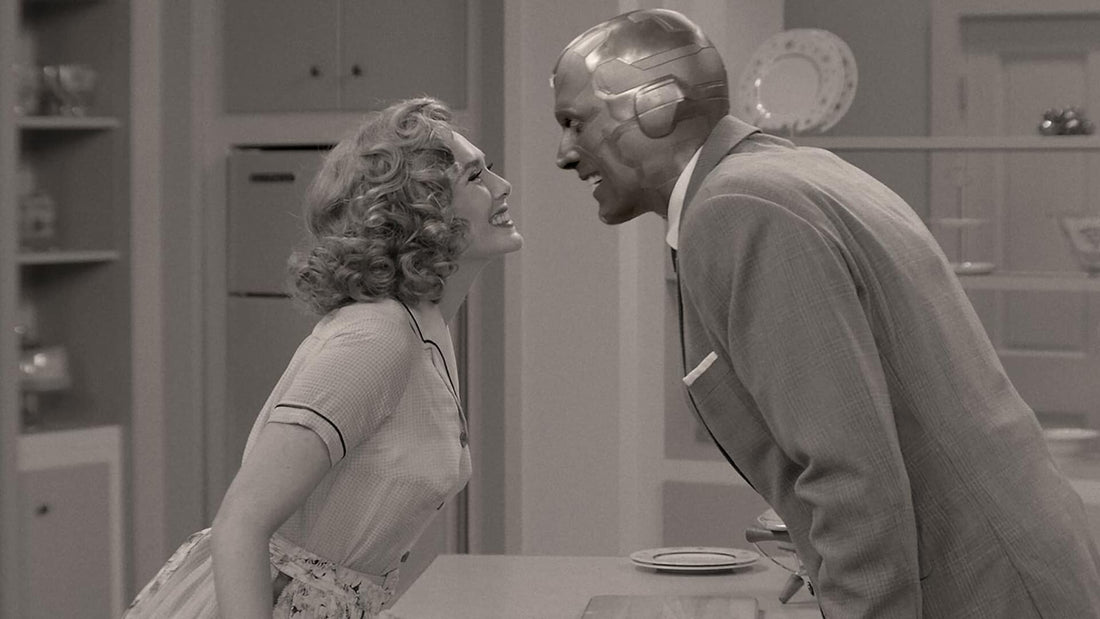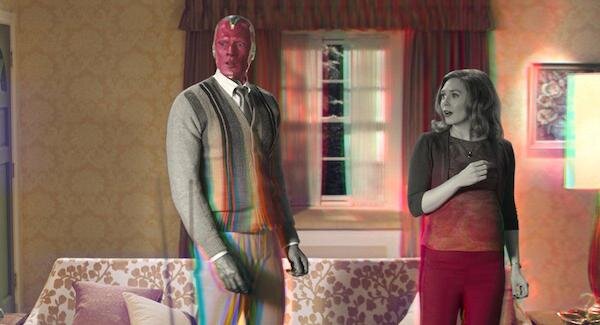Marvel may have moved on from its first landmark series WandaVision, but its unlikely premise felt all too real for Brielle Diskin, who, like Wanda, knew a thing or two about projecting the perfect boyfriend in the aftermath of severe trauma. A love letter to the ways we make up happy endings and dream through our day-to-day, Brielle introduces us to Jesse.
It’s a pretty picture. The image of the blissful couple. At many points in my life, I’ve looked at that picture as if it were the definition of joy. Which is why, during the excruciating years of my early teens, growing up in the suburbs of New Jersey, I created an imaginary boyfriend named Jesse.
It was silly at first. It began with giving the support pillow I slept next to at night a personality. I imagined the things he loved about me (my long-winded monologues on the dangers of capitalism because he liked when I got passionate about things), what our Halloween couple costume would be (Sam and Suzy from Moonrise Kingdom), where we’d raise our kids (a brownstone in Brooklyn), and what we’d laugh about in our old age (that embarrassing thing I did at that place in front of all those people that one time).
While watching Marvel’s WandaVision, I felt a sense of familiarity in Wanda’s world of hexes and synthezoid soulmates. I couldn’t resonate with the trauma she’d suffered throughout the Marvel franchise, nor do I have mind-bending superpowers, but, in a way, Wanda and I were the same. We both hid in the idealized worlds that we’d envisioned for ourselves and our fake boyfriends, in the suburbs of New Jersey.
The series follows the events of Avengers: Endamage after a snap wiped out half of all life in the universe until five years later, the Avengers brought back everyone who had turned to dust, including Wanda Maximoff (known as Scarlet Witch in the comics). Meanwhile, Vision, her one true love, did not come back. He died right in front of her, moments before the snap. Over the course of the Marvel films, Wanda lost her entire family, so here was another loss in the series of unfortunate events that was her life.
Unable to bear a world full of grief and emptiness, Wanda casts a spell over the fictitious suburbia of Westview, New Jersey. In it, she simulates a picture-perfect life for her and Vision constructed by her memories of American family sitcoms throughout the decades.
In each episode, Vision is some rendition of the quintessential TV dad and devoted husband. Despite Wanda manipulating the world the way she wished it would be, Vision already played that role well prior to his death. That kind of support means everything, just as much as losing it does. With Vision there, she was loved. Without him, Wanda would be alone with her agony.
I named my fake boyfriend Jesse, because it sounded like the kind of blank slate name of a guy who I could craft a boyfriend out of. Like Wanda, my imaginary man was a composite of all the television influences I had available to me. So, where Vision was the perfect TV husband of the 20th century, Jesse was the iconic alt TV boyfriend of the 21st century. He had the geekish charm of Seth Cohen from The O.C. and the rugged looks of Jess Mariano from Gilmore Girls.
At 13 years old, Jesse arrived at an age in which I came to know pain intimately. It coincided with the arrival of my womanhood (including the expectations that came with it) and the guest of honor at the puberty party — childhood trauma. Everything that existed outside the confines of my bedroom was uncontrollable. Having experienced abuse at a young age, I am exceptionally sensitive to rejection, abandonment, and betrayal. Ages 13 through 17 can be described in exactly those three words.
I didn’t understand trauma then. It disguised itself as unexplained rage and spontaneous bursts of sadness. The only comfort I found was watching teen soaps like Gossip Girl and One Tree Hill. I immersed myself in hours of dramatized underage romances and unrealistic plot lines, where teenage pregnancies and affairs with teachers were go-to plot twists. It was a chance to leave pain at the door and escape to a place where the rules of reality don’t apply. I noticed that same sense of peace in Wanda’s eyes in the first couple of episodes of the series.
In a flashback scene, presumably before the snap, Wanda explains to Vision why the audience is laughing at Bryan Cranston’s character getting crushed by his latest backyard project in Malcolm in the Middle. She says he’s not really injured, and that’s why it’s funny. When Vision asks her how she’s so certain the injuries aren’t real, she replies, “It’s not that kind of show.”
The medium of television allows a show to dictate its own laws of reality. If the show says it is so, then it is so. In her show, Vision is still alive and they even have children. Her fake world, based on fiction, is a dream. To a dreamer still sleeping, everything is going on in real time. Their dream-like existence allows the perfect picture of the happy couple to truly exist.
Unable to create a hexagonal forcefield around my town and compel everyone in it to act as I wished, reality for me was and is, unescapable. I had to go to school and be a teenager in the world. On a very basic level, this required me to make friends, keep friends, get a boyfriend, lose my virginity as soon as possible, be good in school, be good at sports and so on and so forth. Now do all of this while upholding the appearance on social media that I lived an enviable life. Walking down the halls with no one to talk to, I imagined Jesse was next to me. I ran to the bathroom and pretended I was meeting him at my locker because he so badly wanted to hear about my below-average day. And these are the small things. The big things were tougher, quieter, and darker.
It’s easier to consume myself with menial gossip and idealistic romantic interest, much like I saw on TV. It’s much harder to put your heart on the line for someone real. It’s harder to be okay with being alone, to deal with your problems alone. Having someone on your arm is everything. Being in a relationship feels like a nonverbal declaration that you are worthy of love. And if enough people see it, then enough will love you too. It’s currency for social acceptance.
Women are as valuable as their reproductive potential is within a misogynistic society. On television, as in life, many prefer to see a woman content with a man. WandaVision beautifully turns classic TV tropes on their heads. Wanda looks to the shows that emboldened the domestication of femininity, believing that meant happiness. American family sitcoms, in their golden era, did just that in shows like Donna Reed or All in the Family. But I didn’t grow up with those. I had my nighttime teen soaps.
I was conditioned to believe that girls were less threatening when a guy was there to tame her and, inherently, be her hero. For example, in the O.C., Ryan was the external manifestation of Marissa’s rage. She sat back and suffered while waiting on him to fight off (literally) her bad boyfriends for her. As much as I swooned for Ryan or as much as I believe that Vision is a gem of a man/android (this is Marvel after all), I now reject the idea that I can’t be my own hero without a man.
The lure of an imaginary boyfriend is just that, it's dependency on the hero, or as strong a male presence as you can get. “I can’t handle this on my own,”or “I need a man,” plays on a loop in my head. Throughout the Marvel movies, Wanda always had an avenger to lean on after she’d suffered a loss. When her parents died, she had her brother. When her brother died, she had Captain America as a mentor and then Vision, a love she could share some of the pain with. Male heroes are all she knows. “You are my sadness and my hope”, Wanda says to Vision as the world she built for them crumbles. Where love and hope are absent, illusions can take up the empty space. But reality is inevitable.
When I get a crush, I melt into the fantasy of us, taking pleasure in false feelings of companionship. In the final episode of WandaVision, we see why and how she built her reality-bending safe-haven. Kneeling on the grounds of a home Vision purchased for them, all of the pain of what could be, a crumbling fantasy sunk her to the ground. Witnessing such catharsis borderline high-inducing. So often, I’ve distracted myself with those daydreams, those fantasies. The imaginary intimacy. Meanwhile, those elaborate productions are conjured out of agony, pain, and rage.
In my reality, Jesse was a product of my own suppressing of trauma and the residual feelings of rejection that come from years of abuse. In Wanda’s reality, her artificial world was a response to grief. For both of us, the reality of the pain was all-consuming, so we both looked to conceptualize ideas of men to share the weight.
Brielle Diskin (@briellecaraa) is a freelance culture writer based in New York. She is also the Assistant Editor of The Week Junior, a news magazine for kids. She watches a lot of movies, loves discussing female representation on screen, and is always down to unpack the plot of Holes




